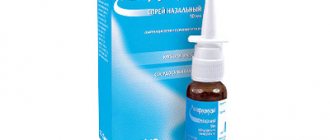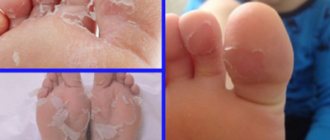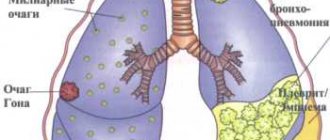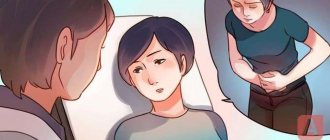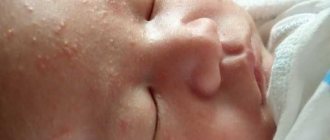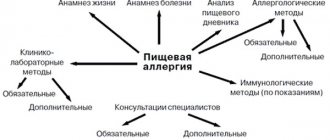Most children often get injured due to their excessive activity. Due to their age characteristics, they are very curious, strive to explore the world, and do this experimentally, forgetting about caution and not thinking about the consequences. The result is abrasions, scratches, and bruises. But sometimes fractures of the nose also occur, which is often subject to injury, especially if the child is actively involved in sports and loves outdoor games with friends.
It is important for parents to know about the signs of nasal fractures in a child and to be able to provide first aid. The health of a growing person depends on this.
How to identify a broken nose in a child
A nasal fracture is a violation of the integrity of the bones of an organ with their subsequent separation from each other, resulting from physical impact. It is a common injury in children. Of all skull injuries, it accounts for almost 50%. This is due to the anatomical features of the organ. It is convex, consists of thin bones, cartilage tissue, covered with muscles and skin. Children's bones and cartilage are not yet strong enough, so they break easily with not very strong mechanical stress.
There are many reasons leading to such an injury. These are hits (from a door, a swing, a ball), falls (from a bicycle, a tree, a fence), fights, and accidents. Children under 3 years of age are at risk, because at this age they begin to actively explore the world, but are completely deprived of a sense of self-preservation.
A fracture can be open when the muscle and skin are torn during the injury. Sometimes bone fragments can be seen with the naked eye. Trauma is fraught with infection in the wound and the development of sepsis. Or closed, in which the injury is not accompanied by a violation of the integrity of the skin. Healing occurs faster.
There are several types of nasal fractures with different manifestations:
- Pyramidal indentation.
There is a displacement of the cartilaginous septum and nasal walls.
- Frontal depression.
As a result of mechanical damage, the septum and both nasal bones are broken. Due to the frontal depression, the shape of the nose changes greatly. It becomes wide and depressed in the middle (saddle-shaped).
- Comminuted fracture.
Occurs due to multiple injuries to the midface.
- With offset.
One paired bone is fractured and the septum is damaged due to a side impact.
Symptoms may vary depending on the type of fracture and its severity. Sometimes the signs are barely noticeable, some of them may be absent. Then the fracture can be easily confused with a bruise.
What signs and symptoms may there be in children?
It is important to recognize in time that the nose is broken. There is no time to waste and see a doctor right away. To correctly assess the situation, all clinical manifestations should be assessed and the correct conclusion should be drawn.
So, when a child has a broken nose, the following symptoms appear:
- Extreme pain. It bothers the child even at rest, and when trying to touch a damaged organ or tissue around it, it intensifies several times.
- Bleeding. It can develop internally, as evidenced by the appearance of hematomas and bruises under the eyes. And externally, when blood oozes from the nostrils.
- Nose deformity. The bones of the organ acquire pathological mobility.
- Rapidly increasing swelling of the tissues of the middle part of the face.
- Breathing problems. If the integrity of the septum has been compromised and it closes the nasal passage, the victim breathes exclusively through the mouth.
- Unpleasant characteristic crunch.
How to recognize a broken arm in a child
What are the main symptoms of any fracture?
- pain;
- dysfunction;
- pathological deformation;
- pathological mobility and
- Crepitation is a characteristic crunching sound that occurs when fragments rub against each other.
With a classic complete fracture (and in older children they predominate), all these symptoms are quite pronounced. With an incomplete fracture (crack), only the first two signs may occur. The same is true for greenstick injuries.
With absolute certainty, fractures are detected only by x-ray examination. However, no one has this device at home, and the decision about whether to go to the emergency room or wait must be made immediately. So here's what to pay attention to:
Pain
The pain occurs at the time of injury, is unbearable and intensifies with the slightest movement of the injured arm. With an incomplete fracture or a “green stick”, it may not be strong and a sufficiently old child can endure it for quite a long time, fearing punishment. However, it cannot hide the second sign:
Dysfunction
Even with an incomplete fracture, the child will spare the injured arm. If it is the right one, then he will stop playing with it, taking a spoon, or holding anything. If, having forgotten himself, he leans on this hand, he will scream and fall. Sound the alarm - your child has an injury that requires medical attention!
Pathological deformation, mobility, crepitus
If the arm is bent in the “wrong” place at a strange angle, and plus the child is screaming in pain, there is a 100% chance of a fracture. This also includes the last two signs - pathological mobility and crepitus. These symptoms are characteristic of injuries in which the fragments are completely separated from each other.
Without going too far off topic, let’s reveal one little secret on how to suspect a fracture in a baby who still can’t tell you anything:
a fallen child cries exactly as much as it hurts.
In other words, if after a fall he cries for 2-3 minutes and quickly calms down in his mother’s arms, you can slowly begin to calm down. If, despite all your efforts, he cries for 10-20 minutes or more, go to the emergency room: the probability of a fracture is almost 100 percent.
What to do if you suspect a fracture
As soon as the baby receives a nose injury (even if it is not clear what kind), it is important for parents not to panic themselves and to calm the victim down. And then begin to act immediately.
First aid for a broken nose
Until the minor is taken to the hospital, it is important to provide him with first aid. He is in extreme pain, so he screams and cries. But sometimes the baby may lose consciousness from painful shock.
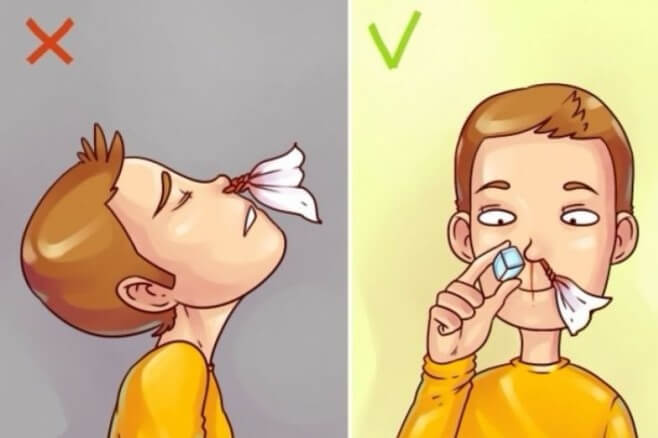
An adult's actions in providing first aid to a child with a broken nose include the following steps:
- Apply cold to the nose area (special cooling packs from the first aid kit, snow, ice, cloth soaked in cold water). This will help stop bleeding and reduce pain.
- Turn and tilt your head slightly to the side.
- Give painkillers.
- Take the victim to the hospital.
Do not let the child touch the damaged area or blow his nose. It is strictly forbidden to try to set protruding bones or insert gauze or cotton into the nostrils. There is no need to lower your head back, otherwise blood may clog your nasal passages.
Any attempts at unqualified therapy can cause disastrous consequences!
Where to go
The child should be seen immediately by a doctor, regardless of whether he received a bruise or a fracture. It's better to call an ambulance. The paramedic will determine the nature of the injury, carry out initial treatment if necessary, and advise which doctor to contact.
Bone fractures in a child: how to recognize and what to do?
It is difficult not to notice a broken bone in a child - because the baby is in pain, he is capricious and crying. When examining the bruised area, you may notice swelling, hematoma, edema and deformation. The child will react painfully to touch and will not be able to move the broken arm or leg. However, you should know that if there are no such symptoms, but the baby still behaves inappropriately after the injury, you should definitely see a doctor. As a result of the injury, a compression fracture of the spine, which is extremely difficult to diagnose, could occur, for example.
First aid for a child with a broken bone
An injured child needs qualified medical care - call an ambulance and begin emergency self-help measures.
- Having recognized a bone fracture in a child, the first thing you need to do is immobilize him: you need to tie a stick or plank to the damaged segment and two adjacent ones (on both sides) - with a bandage, scarf, handkerchief.
- To relieve pain, you need to give your child a painkiller - your home medicine cabinet should have something based on paracetamol or ibuprofen, something that is suitable for the baby’s age.
- If the fracture is open, the wounds need to be treated, and only after that, applying a sterile bandage to avoid infection, immobilize the damaged segment, taking into account the nature of the bleeding.
Behave calmly and businesslike, establish tactile contact with the child - remember that the baby’s nervousness directly depends on your emotional state.
Treatment of fractures in a child is carried out using conservative practice - a plaster cast is applied and, if there is no displacement, the child is even sent home. Follow all doctor's instructions and do not forget that outpatient treatment also requires medical supervision.
It is known that the smaller the child, the faster his bones grow together. For example, to ensure that a one-year-old baby’s collarbone is fused. It only takes 7 days, but the humerus, ulna and radius bones fuse in 12 days.
How is the treatment carried out?
Before prescribing therapy, consultation with pediatric doctors (ophthalmologist, ENT specialist, surgeon and other specialists) is required. An ultrasound examination, radiography, and CT scan of the nasal bones are required. Depending on the complexity of the fracture, different therapy is prescribed. It includes eliminating pain, restoring nasal breathing, preventing the development of infection, and returning the nose to its normal physiological state.
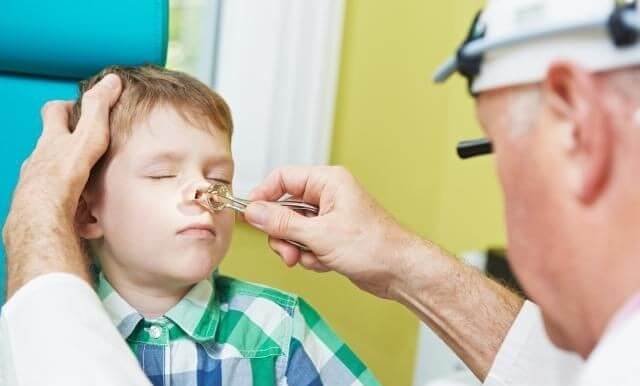
Surgical approach
If less than 24 hours have passed since the injury, the doctor performs a reposition (sets the bones in the correct position). For this purpose, under general anesthesia, a rubber swab with gauze inside is inserted into the nasal passage. It is installed in such a way that the bones are in their natural position. It is left for a month. During this time, the tissues are restored, bone callus appears and complete recovery occurs.
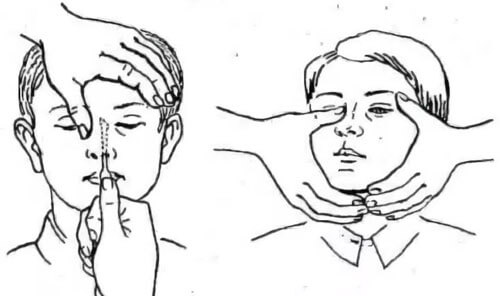
If the parents did not immediately consult a doctor, and there is a possibility of a bent nose, repositioning is performed. It is optimal to carry it out within 3 days after the fracture. The child is seated in a comfortable chair and calmed down. If necessary, a sedative is given. General anesthesia is given and ice is placed on the nasal area. The doctor presses on the root and side walls of the nose, bringing them into the correct position.
If the parents do not take the patient to the doctor within 21 days, a complex operation will be required, during which an osteotomy (break of bones) is performed and they are put in the correct position. The surgery lasts about 3 hours under general anesthesia. Afterwards, a plaster cast is applied to the nose. It is removed after 7 days. But complete healing occurs after 1.5 months.
Use of medications
Doctors also use medications for nasal fractures in children. They are needed to achieve several goals.
They are reflected in the table.
| Goal of treatment | Drugs |
| Relieving inflammation | Antibiotic-based ointments and tablets (Femoxin, Amoxicillin). |
| Elimination of puffiness | Heparin ointment. |
| Anesthesia | Ketorol, Ketanov, Tramadol. |
| Relieving nasal congestion | Drops with a vasoconstrictor effect (Sanorin, Naphthyzin). |
How long does it take for a nose to heal?
In young patients, recovery occurs much better and faster than in adults. The main treatment lasts about 2 weeks. During this time, you need to take prescribed medications and change the bandage. After a month, the fractures heal completely. The doctor conducts an examination, based on the results of which he concludes whether treatment is still needed or whether the child is healthy. If surgery was performed, healing takes longer.
How to distinguish a bruise from a broken nose
To know how to distinguish a nasal fracture from a bruise, you should understand that the latter is not accompanied by a violation of the integrity of the bone and cartilaginous framework of the nose, therefore there are no symptoms such as crepitus, deformation and mobility in the area of injury. These symptoms, however, cannot always be detected during a fracture due to edema and hematomas, so additional research methods are needed to verify the diagnosis - radiography and CT.
X-rays, due to the overlap of shadows of other bones, sometimes do not allow one to recognize a thin fracture line and slight displacement, especially in children. It is advisable to use CT.
Child care during treatment
The recovery period lasts differently for children. It depends on the complexity of the fracture and the general condition of the body. Parents or guardians should provide the sick child with the most comfortable conditions possible during therapy. If antibiotics are prescribed, you need to give the drugs exactly according to the established schedule and ensure that the course is completed in full. During rehabilitation, a small patient should be taken to physiotherapy (UHF to stimulate metabolic processes, improve tissue regeneration, electrophoresis with calcium preparations to prevent the development of inflammation).
The child needs peace, so outdoor games and sports are prohibited. It is better to limit communication with other children (comrades, brothers, sisters, close in age). It is prohibited to use glasses or other objects that have a physical impact on the middle part of the face. You cannot visit the bathhouse or sauna.
Nasal fractures in children are quite common, but by no means harmless. It is important to provide first aid correctly and deliver the baby to the clinic as quickly as possible. Timely treatment by specialists is the key to a complete recovery. But unprofessionalism leads to serious consequences for children in terms of their physical and psychological health.



